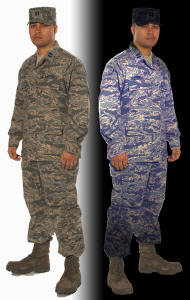
Optical brighteners, which are commonly used in laundry detergents, are not only dangerous for airmen, because they make their uniforms easy to see by night vision equipment and in low-light environments, but they have serious health and environmental effects as well (e.g. skin sensitivity, reproductive issues,
& developmental issues).
Photo courtesy of U.S. Air Force. Part of the public domain in Wikimedia Commons.
What does hair conditioner, your favorite white t-shirt, food packaging, and laundry detergent have in common? They all could potentially contain optical brighteners!
Optical brighteners are a pesky class of synthetic chemicals with negative health and environmental effects that manufacturers love adding to a wide array of products, because they make things appear whiter and brighter.
Remember as a kid how it was so cool to see your white shirt and socks glow when you used a black light? Well, that glow was attributed to optical brighteners. You see, without them your clothing wouldn’t fluoresce. So depending on how old you are, that should give you a pretty good idea of how long these wonderful chemicals have been around.
When optical brighteners are used in laundry detergents, they don’t get clothing any cleaner. They simply trick your eye into thinking your clothing is “clean” by transforming UV light and enhancing the blue light reflected. When used in hair products, like shampoos, conditioners, and hair sprays, they make the hair appear very shiny and help reduce brasiness. In make-up, they minimize the appearance of dark under-eye circles and wrinkles. And in paper products, they almost hurt your eyes they seem so bright! But don’t think paper products just means the stuff you right on. Optical brighteners are also used in paper and plastic products that your food is packaged in. Scary, huh?
Several problems have been associated with optical brighteners such as skin sensitivity, reproductive issues, and developmental effects. From an environmental standpoint, these chemicals can bioaccumulate and don’t readily biodegrade, so potential negative impacts are definitely there, especially considering the amount of these chemicals used. For further information on health and environmental effects, some of the other names these chemicals hide under, green alternatives, and more, check out my About.com article on optical brighteners.
So what can you do? As a consumer make your voice heard with your pocket book. Stop buying non-organic textiles, unnatural hair products, make-up, snow white paper, and laundry detergents with optical brighteners and go for green ones instead. By the way, I recently reviewed a few good laundry detergents without optical brighteners and did some hands-on stain testing to see how well they performed. Check out my reviews on ECOS Liquid Laundry Detergent and Whole Foods Markets’ Green Mission Organic Laundry Detergent.
© Karen Peltier and Well Gal, 2012 – 2015. All rights reserved.
